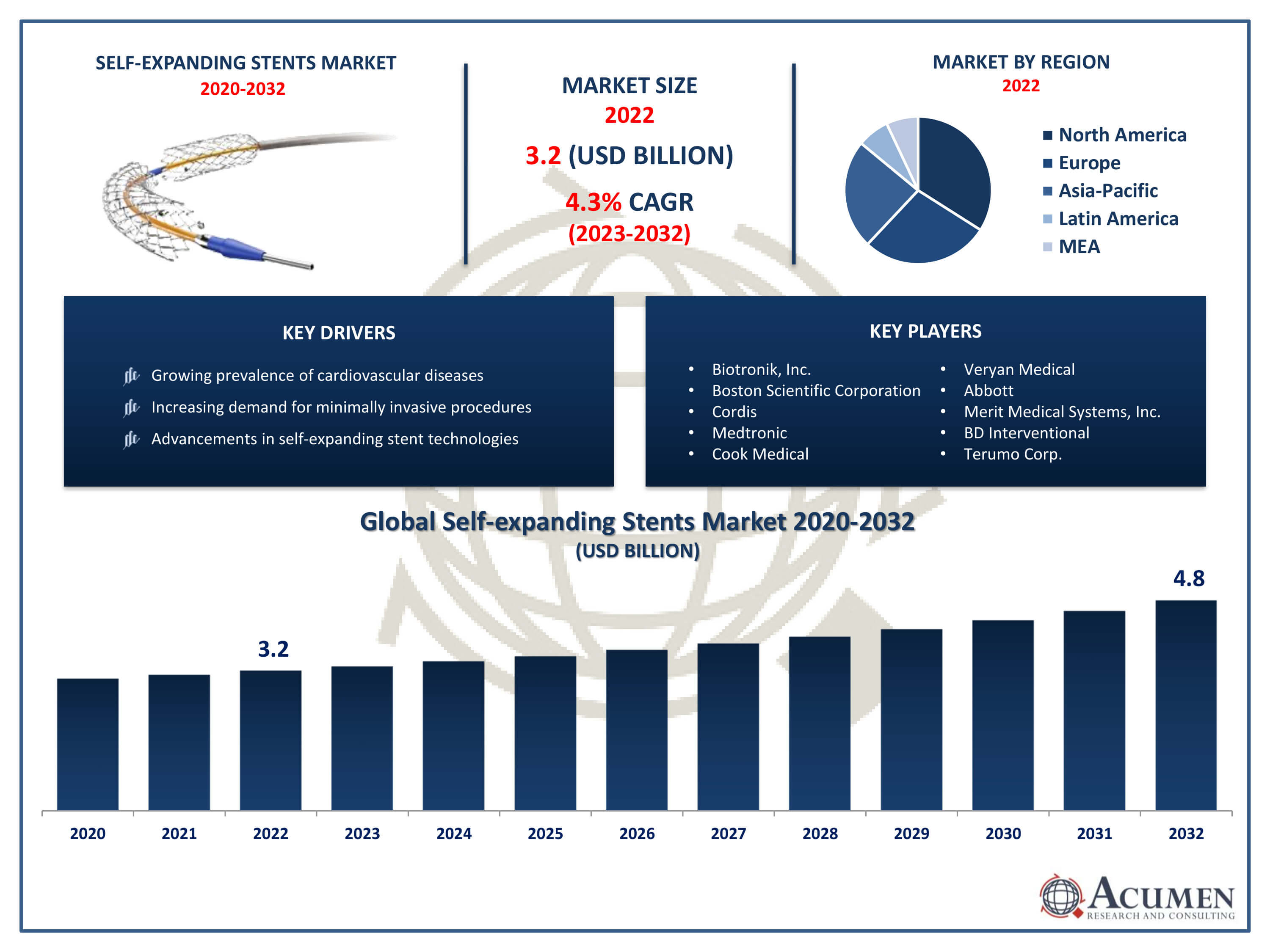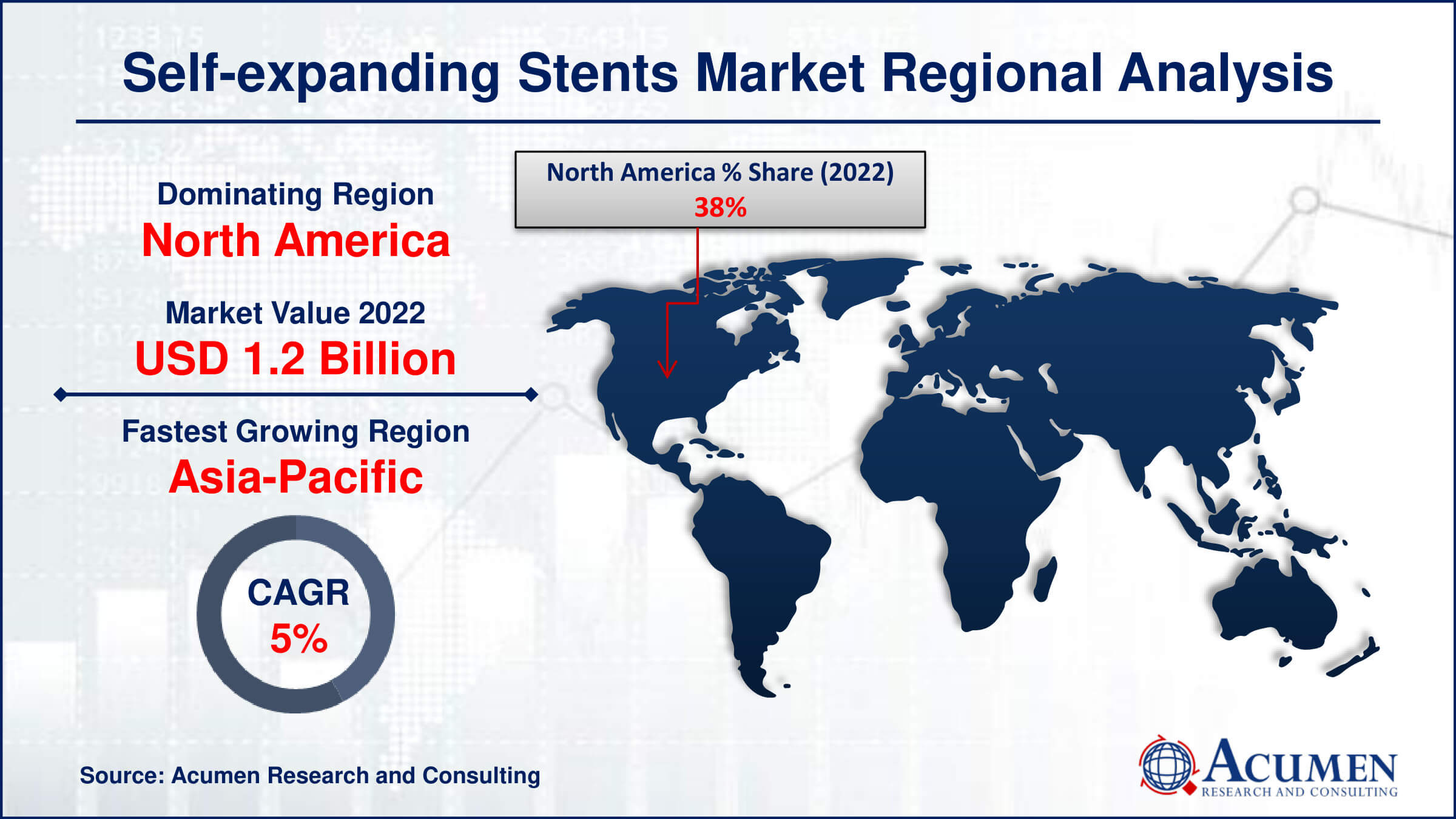December 2020
Self-expanding Stents Market Size accounted for USD 3.2 Billion in 2022 and is projected to achieve a market size of USD 4.8 Billion by 2032 growing at a CAGR of 4.3% from 2023 to 2032.
The Self-expanding Stents Market Size accounted for USD 3.2 Billion in 2022 and is projected to achieve a market size of USD 4.8 Billion by 2032 growing at a CAGR of 4.3% from 2023 to 2032.
Self-expanding Stents Market Highlights

Self-expanding stents are medical devices used in interventional cardiology and other fields to treat narrowed or blocked blood vessels. These stents are designed to expand on their own once deployed at the target site within the body. Typically made of metal alloys, such as nitinol, these stents provide structural support to keep blood vessels open, improving blood flow and preventing complications associated with vessel blockages.
The market for self-expanding stents has been witnessing growth due to several factors. One key driver is the increasing incidence of cardiovascular diseases and peripheral artery diseases globally. As the aging population expands and lifestyle factors contribute to these conditions, the demand for minimally invasive interventions like stent implantation rises. Technological advancements, such as improvements in stent design and materials, also contribute to the market growth by enhancing the efficacy and safety of these devices. Moreover, ongoing research and development activities focused on expanding the applications of self-expanding stents further contribute to the market's expansion.
Global Self-expanding Stents Market Trends
Market Drivers
Market Restraints
Market Opportunities
Self-expanding Stents Market Report Coverage
| Market | Self-expanding Stents Market |
| Self-expanding Stents Market Size 2022 | USD 3.2 Billion |
| Self-expanding Stents Market Forecast 2032 | USD 4.8 Billion |
| Self-expanding Stents Market CAGR During 2023 - 2032 | 4.3% |
| Self-expanding Stents Market Analysis Period | 2020 - 2032 |
| Self-expanding Stents Market Base Year |
2022 |
| Self-expanding Stents Market Forecast Data | 2023 - 2032 |
| Segments Covered | By Product Type, By Application, By End-User, And By Geography |
| Regional Scope | North America, Europe, Asia Pacific, Latin America, and Middle East & Africa |
| Key Companies Profiled | Biotronik, Inc., Boston Scientific Corporation, Cordis, Medtronic, Cook Medical, Veryan Medical, Abbott, Merit Medical Systems, Inc., BD Interventional, and Terumo Corp. |
| Report Coverage |
Market Trends, Drivers, Restraints, Competitive Analysis, Player Profiling, Covid-19 Analysis, Regulation Analysis |
Self-expanding stents are typically made of metal alloys, such as nitinol, and are engineered to expand on their own once deployed in the target area. The self-expanding mechanism allows the stent to conform to the shape and size of the blood vessel, providing structural support and preventing it from collapsing. This technology is commonly utilized in interventional cardiology to treat conditions such as coronary artery disease and peripheral artery disease, where blood vessels become narrowed or blocked due to atherosclerosis. The applications of self-expanding stents extend beyond cardiology to other medical fields, including neurology and gastroenterology. In neurovascular interventions, these stents are used to treat conditions like intracranial aneurysms and stenosis. In gastroenterology, self-expanding stents are employed to address strictures or blockages in the digestive tract caused by conditions such as colorectal cancer.
The market for self-expanding stents has been experiencing significant growth, driven by several key factors. The increasing incidence of cardiovascular diseases, coupled with a growing aging population globally, has led to a higher demand for interventional cardiology procedures, where self-expanding stents play a crucial role. These stents are favored for their ability to provide effective vessel support and restore blood flow in a minimally invasive manner, aligning with the broader trend in healthcare towards less invasive treatment options. Furthermore, continuous advancements in medical technology and ongoing research and development efforts have contributed to the expansion of the self-expanding stents market. Innovations in stent design, materials, and delivery systems have improved the safety and efficacy of these devices, making them more appealing to healthcare professionals and patients alike. The market growth is also fueled by the rising preference for outpatient procedures and the potential for quicker patient recovery associated with self-expanding stent interventions.
Self-expanding Stents Market Segmentation
The global Self-expanding Stents Market segmentation is based on product type, application, end-user, and geography.
Self-expanding Stents Market By Product Type
According to the self-expanding stents industry analysis, the carotid self-expanding stents segment accounted for the largest market share in 2022. Carotid self-expanding stents are specifically designed for the treatment of carotid artery stenosis, a condition where the carotid arteries, which supply blood to the brain, become narrowed or blocked. This segment has witnessed increased adoption due to the rising incidence of carotid artery diseases, often associated with atherosclerosis and an aging population. As a preventive measure against stroke, carotid artery stenting with self-expanding stents has become a preferred choice, particularly in cases where patients are deemed high-risk candidates for surgery. Moreover, advancements in the design of carotid self-expanding stents, including improved flexibility, navigability, and reduced risk of complications, have contributed to their growing acceptance in clinical practice. The focus on minimizing procedural risks and enhancing patient outcomes has driven innovation in this segment, making carotid self-expanding stents an integral part of the overall strategy for managing carotid artery diseases.
Self-expanding Stents Market By Application
In terms of applications, the carotid artery segment is expected to witness significant growth in the coming years. Carotid artery stenting (CAS) using self-expanding stents is a minimally invasive procedure designed to treat carotid artery stenosis, a condition characterized by the narrowing of the carotid arteries that can lead to stroke if left untreated. This segment's growth is primarily fueled by an increasing prevalence of carotid artery diseases, often associated with aging, atherosclerosis, and other risk factors. The demand for carotid self-expanding stents has been driven by the advantages they offer over traditional surgical interventions. CAS procedures are considered less invasive, leading to shorter recovery times and reduced hospital stays. Moreover, advancements in stent design and technology have aimed to improve the safety and efficacy of the procedure, enhancing patient outcomes.
Self-expanding Stents Market By End-User
According to the self-expanding stents market forecast, the hospitals segment is expected to witness significant growth in the coming years. Hospitals are witnessing a steady increase in the utilization of self-expanding stents, particularly in interventional cardiology and vascular surgery departments. The growth of this segment is influenced by the rising prevalence of cardiovascular diseases, prompting a higher number of patients to seek medical attention and treatment in hospital settings. Additionally, the increasing adoption of minimally invasive procedures, where self-expanding stents play a crucial role, contributes to the growth of the hospital segment. Hospitals are well-equipped with advanced medical technologies and experienced healthcare professionals who are adept at performing interventional procedures.
Self-expanding Stents Market Regional Outlook
North America
Europe
Asia-Pacific
Latin America
The Middle East & Africa

Self-expanding Stents Market Regional Analysis
North America has been a dominating region in the self-expanding stents market, owing to several factors that contribute to its leadership in this sector. The region boasts a highly developed healthcare infrastructure with advanced medical facilities and a strong focus on technological innovations. The prevalence of cardiovascular diseases, including conditions that require the use of self-expanding stents, is relatively high in North America, contributing to the significant market share. Moreover, the proactive regulatory environment and well-established reimbursement systems in the United States and Canada have facilitated the widespread adoption of self-expanding stents. The presence of key market players and medical device manufacturers in North America further strengthens its dominance, as these companies invest heavily in research and development, bringing cutting-edge technologies and products to the market. The region's healthcare professionals are also early adopters of innovative medical interventions, contributing to the rapid acceptance of self-expanding stents in clinical practice. As the aging population in North America continues to grow and healthcare systems prioritize advanced treatment modalities, the region is expected to maintain its dominance in the self-expanding stents market.
Self-expanding Stents Market Player
Some of the top self-expanding stents market companies offered in the professional report include Biotronik, Inc., Boston Scientific Corporation, Cordis, Medtronic, Cook Medical, Veryan Medical, Abbott, Merit Medical Systems, Inc., BD Interventional, and Terumo Corp.
Looking for discounts, bulk pricing, or custom solutions? Contact us today at sales@acumenresearchandconsulting.com
December 2020
June 2021
November 2020
September 2021